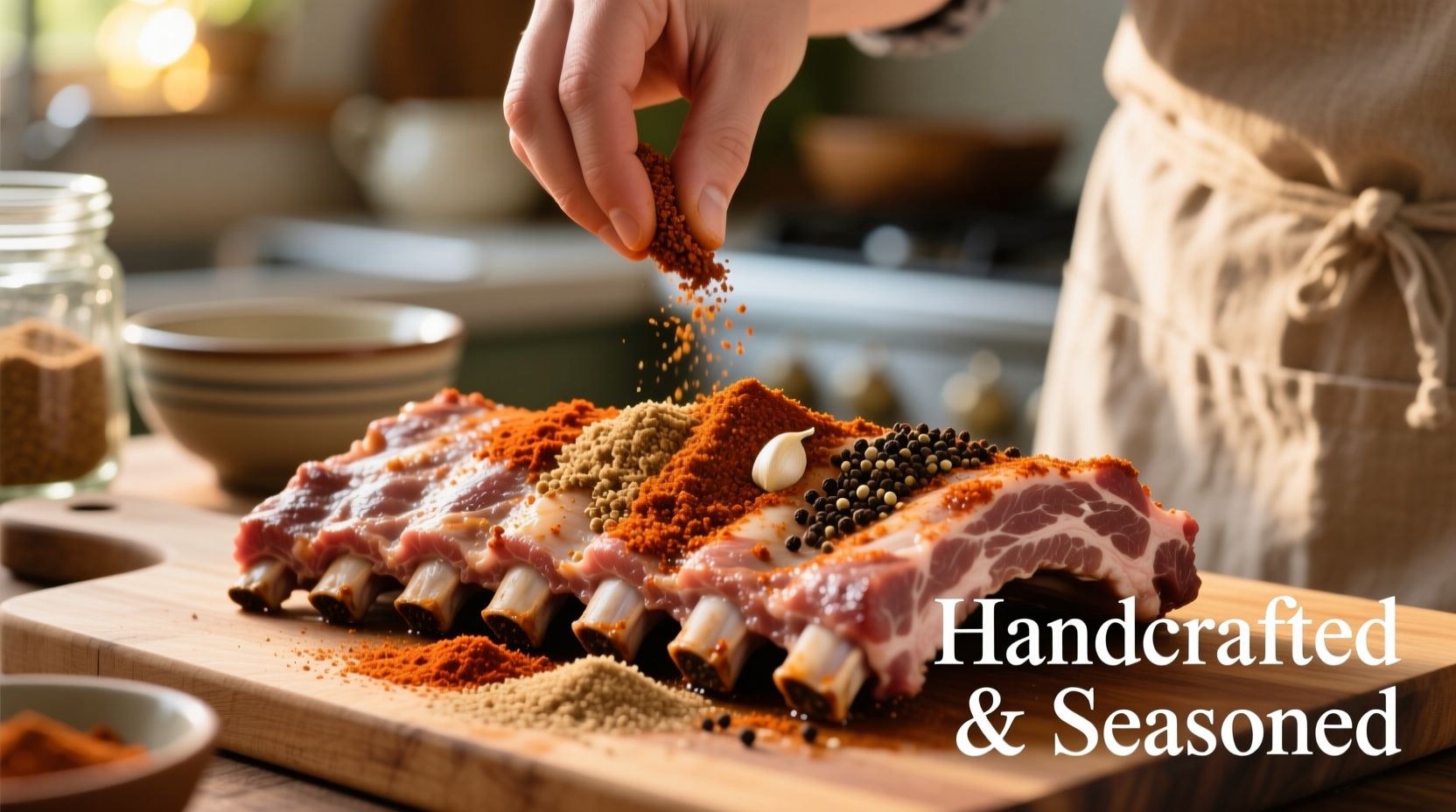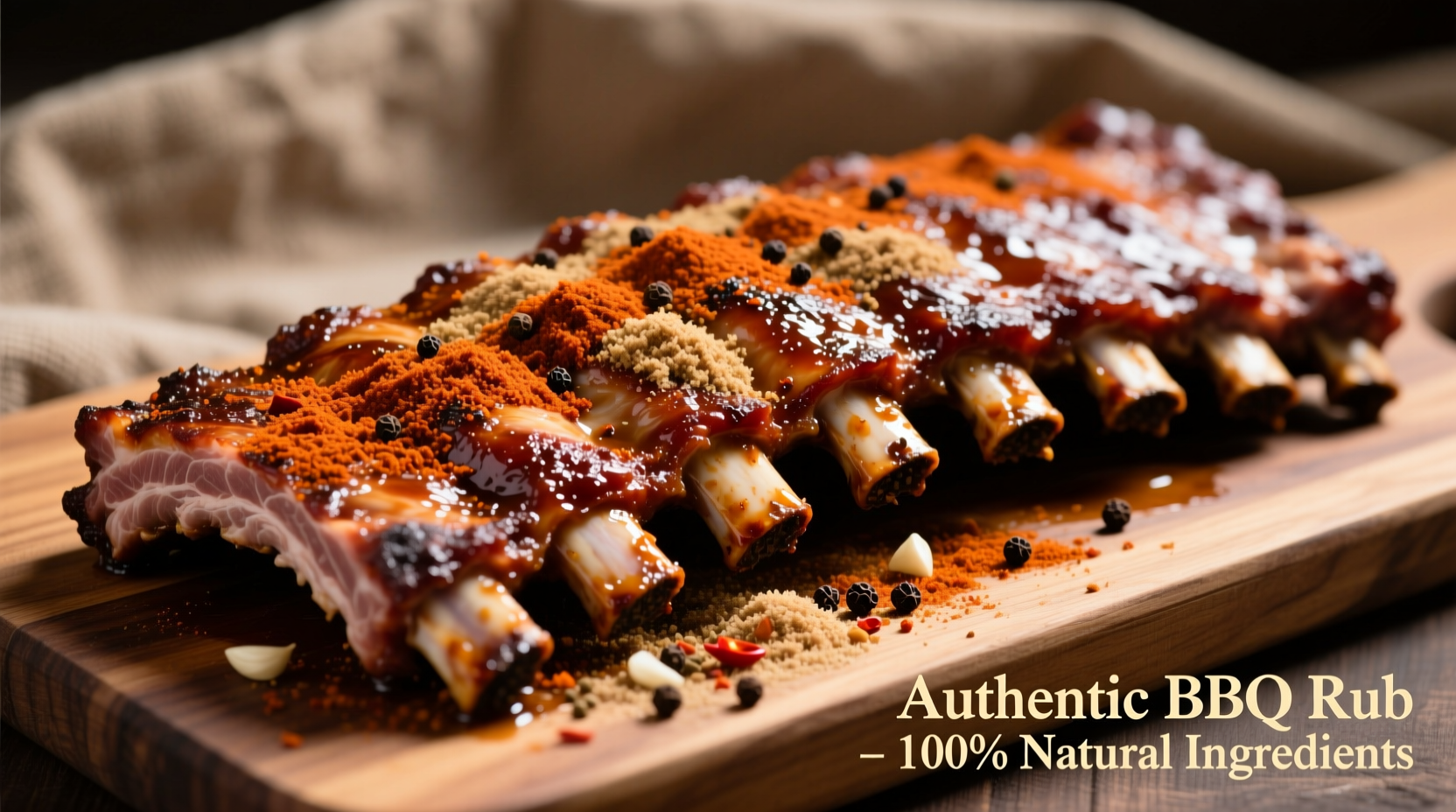Looking for the perfect spice rub for pork ribs? This balanced blend of paprika, brown sugar, garlic powder, onion powder, salt, black pepper, and cayenne delivers restaurant-quality results with just 5 minutes of prep time. The combination creates a flavorful crust through the Maillard reaction while allowing the natural pork flavors to shine.
The Science Behind Effective Pork Rib Rubs
Understanding why certain spices work with pork ribs transforms your results from good to exceptional. Pork's mild flavor profile acts as a perfect canvas for complex spice blends, but the magic happens through chemical reactions during cooking.
Food science research from the USDA National Institute of Food and Agriculture confirms that salt in rubs helps break down muscle fibers, allowing deeper flavor penetration. Meanwhile, the sugar component (typically brown sugar) facilitates caramelization at around 320°F (160°C), creating that desirable crust without burning.
| Key Component | Function | Optimal Percentage |
|---|---|---|
| Salt | Flavor enhancer & tenderizer | 25-30% |
| Sugar | Caramelization & balance | 20-25% |
| Paprika | Color & mild heat foundation | 15-20% |
| Aromatics (garlic/onion) | Complexity & depth | 15-20% |
| Pepper & heat elements | Finish & dimension | 10-15% |
Essential Ingredients for Maximum Flavor Impact
Not all spice rubs deliver equal results. The quality and freshness of your ingredients directly impact the final flavor profile. Here's what makes each component essential:
- Paprika - Provides rich color and foundational flavor. Hungarian sweet paprika offers depth without excessive heat, while smoked paprika adds barbecue authenticity
- Brown sugar - Creates caramelization and balances saltiness. Dark brown sugar adds molasses notes that complement pork's richness
- Garlic powder - More stable than fresh garlic when applied early, preventing burning while delivering savory notes
- Onion powder - Complements garlic with sweet, earthy notes that enhance meat's natural umami
- Sea salt - Kosher salt's structure helps it adhere better and distribute more evenly than table salt
- Black pepper - Freshly ground provides brighter flavor than pre-ground versions
- Cayenne pepper - Adjustable heat component that should enhance, not dominate, the flavor profile

Step-by-Step Perfect Pork Rib Rub Recipe
This professional-tested recipe yields enough rub for 2-3 full racks of ribs (about 4-6 pounds of meat):
Basic Pork Rib Rub Recipe
- ¼ cup paprika (Hungarian sweet or smoked)
- 3 tablespoons dark brown sugar, packed
- 2 tablespoons kosher salt
- 1 tablespoon garlic powder
- 1 tablespoon onion powder
- 1½ teaspoons freshly ground black pepper
- ½-1 teaspoon cayenne pepper (adjust to heat preference)
Preparation Instructions
- Combine all ingredients in a small bowl
- Whisk thoroughly to ensure even distribution
- Store in an airtight container away from light and heat
- Use within 3 months for optimal flavor (though safe indefinitely)
Proven Application Techniques for Maximum Flavor
How you apply your rub matters as much as the recipe itself. Professional pitmasters follow these science-backed methods:
Timing is critical - Apply the rub at least 1 hour before cooking, but ideally 12-24 hours in advance. Research from the Culinary Institute of America's Food Science Department shows salt needs 8-12 hours to fully penetrate meat and begin tenderizing muscle fibers.
Moisture management - Pat ribs completely dry before applying rub. A light coating of yellow mustard or olive oil (about 1 teaspoon per rack) helps the rub adhere without creating steam that prevents proper bark formation.
Application method - Use your fingers to press the rub into the meat with moderate pressure, covering all surfaces evenly. Don't pile rub excessively - a thin, even layer creates better texture than thick clumps.
Customization Options for Different Taste Preferences
While the basic recipe works for most palates, these professional variations let you tailor the rub to specific preferences:
Sweet Maple Variation
Replace brown sugar with 2 tablespoons pure maple sugar plus 1 tablespoon brown sugar. Add ½ teaspoon ground cinnamon for depth. Ideal for competition-style ribs where judges expect pronounced sweetness.
Spicy Chipotle Variation
Replace 1 tablespoon paprika with chipotle powder. Increase cayenne to 1½ teaspoons. Add ½ teaspoon ground cumin. Perfect for those who enjoy complex heat that builds gradually.
Smokehouse Variation
Add 1½ teaspoons liquid smoke to the mustard binder before applying rub. Increase smoked paprika to 3 tablespoons total. Creates authentic wood-smoked flavor even when using gas grills or ovens.
Regional Rub Style Comparison
America's barbecue regions have developed distinct spice rub traditions. Understanding these differences helps you choose the right profile for your taste:
| Region | Signature Characteristics | Best For | Key Differentiators |
|---|---|---|---|
| Memphis | Dry rub focus, minimal sugar | Purists who want to taste the meat | Higher salt content (35%), minimal sugar (10%), prominent paprika and pepper |
| Kansas City | Balanced sweet and savory | Most home cooks | Moderate sugar (20-25%), balanced salt (25%), includes both paprika and chili powder |
| Texas | Pepper-forward, minimal sugar | Beef brisket lovers adapting to ribs | Heavy black pepper (25%), low sugar (10%), often includes cumin |
| Carolina | Vinegar-based with light rub | Those preferring tangy profiles | Very light rub (mostly salt and pepper), vinegar mop sauce essential |
Avoiding Common Rub Application Mistakes
Even with a perfect recipe, these errors can ruin your results:
- Applying to wet meat - Creates steam instead of sear, preventing proper bark formation
- Using pre-ground spices past their prime - Spices lose potency after 6 months; test freshness by rubbing between fingers and smelling
- Over-applying sugar - Causes burning before meat is fully cooked (keep sugar content below 25%)
- Not allowing resting time - Rub needs at least 1 hour to hydrate and adhere properly
- Skipping the binder - A light coating of oil or mustard significantly improves rub adhesion
Perfect Pairings for Your Rubbed Pork Ribs
Complete your meal with these professional pairing recommendations:
- Sauces - Apply barbecue sauce during the final 30 minutes of cooking to prevent burning. A vinegar-based sauce complements sweet rubs, while tomato-based works better with drier rubs
- Sides - Creamy coleslaw balances richness, baked beans absorb smoke flavors, and cornbread soaks up juices
- Drinks - Medium-bodied red wines like Zinfandel cut through richness, while amber ales complement smoky notes











 浙公网安备
33010002000092号
浙公网安备
33010002000092号 浙B2-20120091-4
浙B2-20120091-4